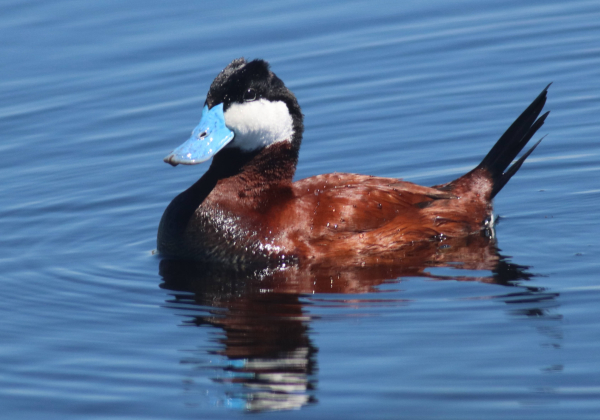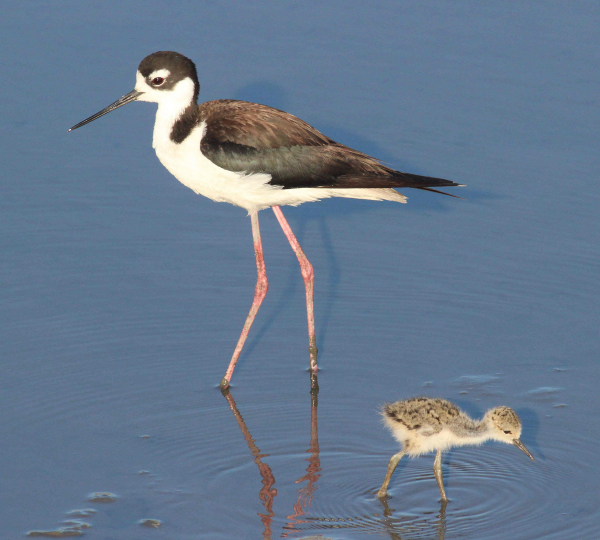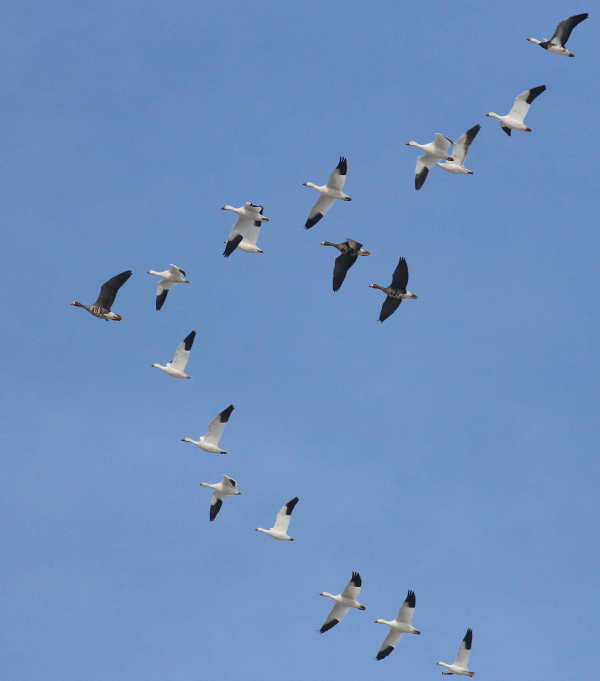
A displaying Ruddy Duck in alternate plumage hopes to attract a nearby female during the initial phase of the nesting season.

A week after hatching, a precocial Black-necked Stilt hatchling forages on the edge of a shallow shoreline under the protection and direction of an adult.

Even a majestic Bald Eagle can look mottled during its late summer molt.

A flock of geese is emblematic of migrating birds; in this case, it’s a mixed-species flock of Snow, Ross’s, and White-fronted Geese migrating together.
|
Over millennia birds have adapted to and evolved with the seasonal changes in a diversity of habitats in regions ranging from the Arctic to temperate regions north, and south, in the tropics and on to the Antarctic realm. From puffins to penguins, parrots to eagles, birds have become tied into the changing seasons – almost on a day to day, week to week basis. As birders, we follow birds’ migrations, nesting seasons, and post-nesting activities – and frankly, that’s what excites us and keeps us alert to the changes and cycles that dominate and direct the seasonality and cycles of birds.
Birders are in touch with the birds around them like no other group of people, in their yards and wherever they go, whether actively birding or when involved in other activities ranging from work to pleasure. We are always alert to what birds we are seeing and how that relates to last week, last month, and last year. And we can use that information, as a memory recall and a written or computerized record, to manage expectations, predict next month’s avian activities, and plan seasonal field trips and birding travels.
Bird behavior changes with the seasons, in cinque with their internal physiology. Many species’ changes in physiology and behavior are reactions to the lengthening sunlight day by day during late winter and spring. The most obvious seasonal changes take place when species begin molting into more colorful or more striking breeding plumage. Some birds respond to spring conditions to initiate a northbound migration that can cross continents and seas as well as climatic regions. Birds make their migrations in flocks, sometimes very large flocks; some birds undertake individual migration flights.
These are activities we birders wait in anticipation for, and revel in when they take place. The timing of such activities varies considerably between Arctic-nesting geese and mountain-nesting hummingbirds, but these differences provide a prolonged spring cycle for birders with waves of different birds migrating through our states and even our neighborhoods, keeping us alert and fulfilled but anticipating more as the season progresses.
Birds’ diets may even change, such as when seed eaters like Northern Cardinals and native sparrows switch from their staple diet of seeds as a result of the seasonal availability of insects that provide more protein that fuels egg production and provides dietary requirements for fast-growing nestlings. Hatches of flying insects in northern latitudes fuels many migrants, including flycatchers, kingbirds, warblers, vireos, tanagers, and many other songbirds.
The nesting cycle is a whirlwind of activities for birds, ranging from mating displays and singing to selecting a nesting territory and initiating nest building. How we enjoy this period of the annual cycle of birds! And again, there is a lot of variation that keeps us excited from when the first Great Horned Owls and Bald Eagles begin laying their eggs through the nesting season when multiple clutches are laid by American Robins and Anna’s Hummingbirds that may still be raising nestlings into August.
The incubation period yields to the hatching stage when altricial nestlings are confined to a nest site, and when precocial birds (hatchlings) pop out of their eggs and start walking or swimming and searching for their own foods within hours of hatching. Ah, what fun it is for birders to witness individuals of a new generation of their species, and as they add diversity to a new avian community across their varied habitats.
Often overlooked, but perhaps the most important of the nesting stages, is the post-fledging period when young birds leave their nest and learn to fly and forage for food on their own. The post-fledging period can vary from a number of hours or a few days for species of hummingbirds to a month or several months for eagles and other large birds of prey. The post-fledging period may lead to an extended family life for birds such as cranes, swans, and geese, swans that may continue to associate as a family group until the adult pairs prepare for the next nesting period the following spring.
After nesting, adults tend to begin a post-nesting molt, but bird molts are complicated and tend to be family-specific, if not genus-specific. Even so, although the varied plumages even within the same species of some songbirds can be tricky, birders appreciate the varied plumages of birds as they molt during the nesting season, the post-nesting period, and thereafter. Certainly being able to distinguish alternate and basic plumages (often referred to as breeding and winter plumages) makes us better birders, as does being able to identify differences in sexes (male, female) and age (adult, juvenile, immature) possible in some species, which is interesting as well as useful for record keeping.
And that’s where we’re at today: We’re facing the end of the nesting season, the continuing post-fledging season, and the tricky post-nesting molts of songbirds, eclipse plumages of ducks, the flightless stage of geese and swans, and the rough-looking, feathers-missing, dog days of August. But fall migration has begun; Arctic-nesting sandpipers and plovers are returning to temperate climes and coastal areas, songbirds are leaving nesting territories, waterfowl are congregating in molting flocks, raptors are initiating post-nesting movements (not necessarily southbound), and new additions to each species are testing their flight skills for the coming migration while trying to survive the rigors of life beyond the nest.
Clearly, with the initiation of fall migration, we’re looking forward to an exciting, extended period when wave after wave of species and species groups move into our homelands, and migrate beyond our reach. Fall is another time to enjoy the action and changes precipitated by the change of the season and the cycles of bird life. It’s time to keep your senses sharp for new arrivals, and to travel to fall hotspots, near and far – and planning is half the fun as you adapt to the new birding cycle too.
Along the way, enjoy your appreciation for birds, improve your birding skills, add new details to your record keeping, and above all, enjoy yourself and the birds around you!
Article and photographs by Paul Konrad
Share your birding experiences anytime at editors2tbw@gmail.com